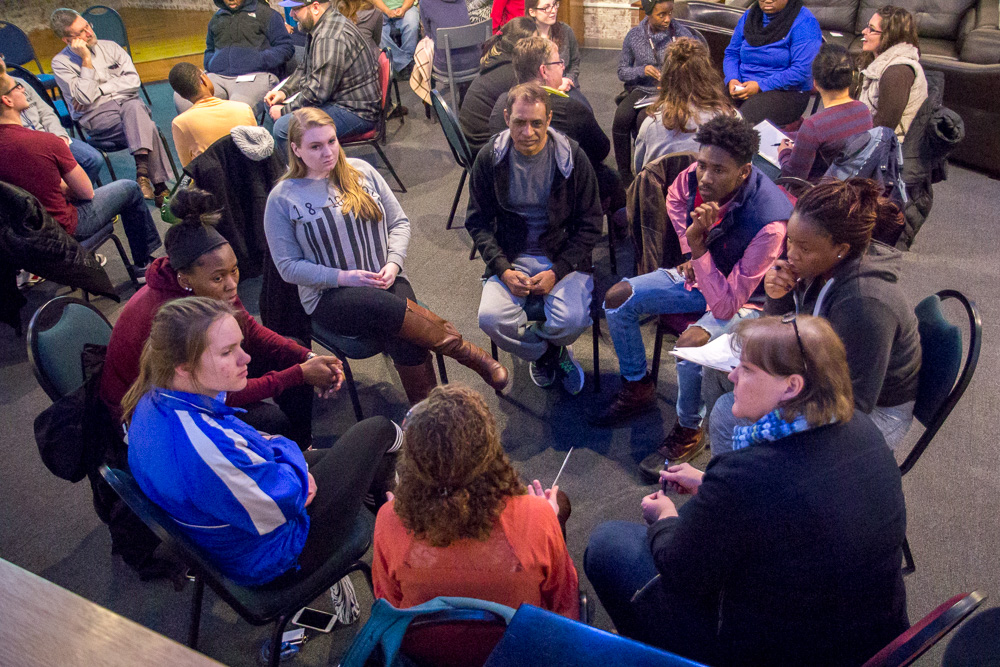Participants at Eastern Mennonite University’s second annual Town Hall on Race at Eastern Mennonite University Feb. 9 asked for more awareness about the role of race in relationship-building and interactive opportunities to build those relationships within the campus community.

The 2-hour event was hosted by Black Student Union and facilitated by co-presidents Tae Dews and Oksana Kittrell. Approximately 30 participants represented a wide swath of campus constituents, including undergraduate and graduate students, and faculty and staff.
“Our goal is to increase knowledge and awareness of how race impacts relationships, foster a sense of commitment, engage faith in the struggle against oppression, walk away with some concrete steps to help us work on this, and lastly, we want you to form relationships with people you may not know,” Dews said.
Rapport was built, first with brief introductions within the group, followed by honest expressions about current comfort levels, and then sharing of personal awareness of race, one’s own and others.
Throughout the evening, the conversation was punctuated by shared laughter — a sign, Dews said later, that people were “keeping it real.” This was a reference to the theme of the 2016 event, “Keeping It Real,” which aimed at fostering genuine conversation.
“I think, from what I heard after each discussion time, that these were some pretty in-depth conversations,” Dews said. “This was a different crowd from last year, more diverse and with more faculty involved. That is very important and I’m really happy to see that step taken.”
“This conversation is important for the community and specifically for the kind of community EMU wants to be,” Kittrell said. “We’re really excited to see people’s willingness to step away from their friends and meet other people. Talking about this topic means we have to build a safe space with people you are comfortable sharing your thoughts with, and I think this event helped people do that.”

Two 30-minute discussions moved participants through major themes of race and relationships on campus and the role of personal responsibility to foster and create relationships with others. A concluding section encouraged participants to think about concrete steps towards bridge-building.
Some issues of concern that have affected relationship-building between races are a perception of being targeted and isolated in the residence halls; the effort it takes to “get to know people outside the white Mennonite bubble”; a general reluctance to address issues of race both by faculty and in the campus community; and the pressure of being an individual who is asked to represent or speak on behalf of a larger group of people.
One white participant said her primarily white friend group recognizes their homogeneity and wants to interact with people of color, “yet we don’t want to force those connections.”
A discussion about personal responsibility led to several points being made about “having to be OK with being uncomfortable” and “be uncomfortable together.”
Groups talked the possibilities of departments creating other opportunities to form relationships.
“Jesus’s vision is multi-cultural,” one group reported. “We talked about a willingness to listen and learn and raise questions, making sure reasons for branching out are genuine.”
After one participant asked a question about internalizing racial hostility, Dews thanked her for the question and then humorously pointed out the sheer wealth of experience and knowledge present in the room.
“That’s a great question,” he said, to laughter in the audience, “and we have a couple of Center for Justice and Peacebuilding professors and graduate students and some sociology professors and over there is an education professor. I am sure they can help us out.”
At the end of the night, participants shared their hopes and goals, speaking to the question of “What can the EMU community uphold you to?”
Faculty member Johonna Turner, professor of restorative justice, urged student-participants to be willing to create “spaces where people can meet and build bridges.”
“There’s a real opportunity for student-led spaces,” she said, “and faculty can continue to support the agency and leadership of students to continue to create those spaces. There is a lot of agency on this campus for that kind of work.”

Looking on from the outside, how is the BSU by definition not racist? How would it go over if the school had a ‘white student union’? We call that racist. Or how about a ‘white congressional caucus’? Does it not work both ways? We are humans of the human race. I left EMC yrs ago and went to work in NYC. I worked with people… oh, who happened to be black, hispanic, white, brown, Jewish, catholic, and I was a WASP. What a menagerie of people, of humans. We worked together well during that time of considerable racial tension. I have worked along side of many people over the yrs, good people, and BTW, some had skin darker than mine. I think Aretha Franklin summed up a lot of the need we have in the relations interaction between different peoples groups… R.E.S.P.E.C.T. BTW , this needs to flow both directions.